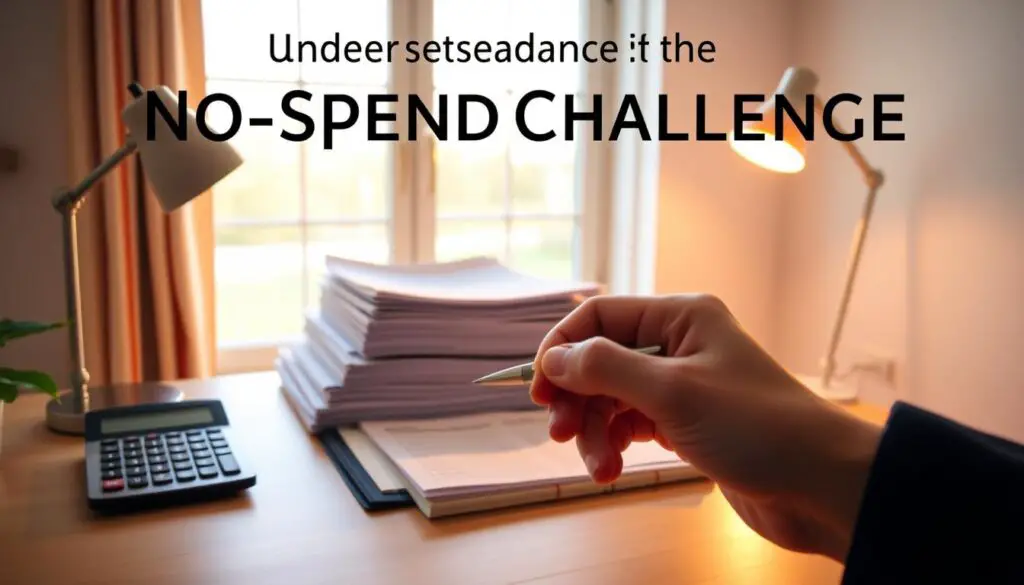Ever feel like money disappears quickly? The no-spend challenge might be what you need. It can help you take back control of your spending and improve your financial health in a short time.
A no-spend challenge isn’t about cutting back for the sake of it. It’s a smart way to reset your finances. It helps you stop spending on things you don’t need and find what’s truly important. By not spending on things you don’t need, you learn a lot about your spending habits.
This approach isn’t about being strict. It’s a chance to make your spending match your values and goals. If you struggle with buying things on impulse or want to have a better relationship with money, a no-spend challenge can guide you.
Key Takeaways
- Understand the core principles of a no-spend challenge
- Learn how to reset your financial mindset
- Discover strategies for controlling discretionary spending
- Develop sustainable financial wellness habits
- Gain clarity on essential versus non-essential expenses
Understanding the No-Spend Challenge Concept

A spending freeze can help you reset your financial mindset. It lets you break free from buying things you don’t need. The no-spend challenge encourages you to look closely at your spending. It helps you adopt a minimalist lifestyle that focuses on financial health.
The no-spend challenge is a smart way to manage your money. It involves limiting what you spend on things you don’t really need. This helps you know the difference between must-haves and nice-to-haves, making you more mindful of your money.
What Qualifies as Essential Spending
Essential spending is what keeps you going financially. These are the must-haves:
- Housing (rent or mortgage payments)
- Utilities (electricity, water, heating)
- Groceries for basic nutrition
- Critical medications
- Transportation for work
What to Eliminate During the Challenge
To really reset your finances, cut out spending on things you don’t need. Stop buying:
- Dining out and takeaway meals
- Subscription services
- Impulse shopping
- Entertainment expenses
- Unnecessary clothing purchases
Duration Options for Your Challenge
You can make your spending freeze fit your life and goals. You can choose from:
- Weekend Challenge: A quick 2-3 day reset
- One-Week Challenge: A short but impactful financial detox
- Month-Long Challenge: A comprehensive financial transformation
- Quarterly Challenge: Extended financial discipline
Choosing the right time depends on your financial situation and how committed you are. Start small and gradually make the challenge longer as you get more confident in your minimalist lifestyle.
Benefits of Starting a Financial Reset

Starting a no-spend challenge can change your money habits. It helps you become more mindful of your spending. This approach is more than just budgeting; it’s a deep reset of your financial mindset.
The main benefits of a financial reset are:
- Identifying and eliminating unnecessary spending patterns
- Developing robust debt reduction strategies
- Reducing financial stress and anxiety
- Building sustainable long-term financial habits
Money mindfulness is key during this journey. By stopping your spending, you see your financial habits clearly. This lets you tell the difference between needs and wants.
| Financial Benefit | Potential Impact |
|---|---|
| Spending Awareness | Reduce unnecessary expenses by 30-50% |
| Debt Reduction | Accelerate debt payoff through strategic saving |
| Psychological Wellness | Decrease financial stress and improve mental clarity |
Your no-spend challenge is a powerful tool for financial change. By consciously redirecting your resources, you make room for important financial goals and stability in the long run.
Preparing for Your No-Spend Challenge
Starting a no-spend challenge needs careful planning and clear goals. Your prep work can help you stick to it and save money. It’s important to think it through and set realistic goals.
Creating a Realistic Budget
Start by understanding how you spend your money. Track your expenses for a month to find where you can save. Divide your spending into must-haves and nice-to-haves:
- Fixed expenses (rent, utilities, insurance)
- Groceries and essential food items
- Transportation costs
- Discretionary spending
Setting Clear Financial Goals
Your no-spend challenge should have a clear reason. It could be saving for a big goal or changing your spending habits. Make sure your goals are specific:
- Paying off credit card debt
- Building an emergency fund
- Saving for a major purchase
- Reducing unnecessary expenses
Building an Emergency Fund Buffer
Having a solid emergency fund is key to your financial health. Try to save enough for 3-6 months of basic needs. Start small if you need to, but keep saving regularly. Use automatic transfers to make saving easier.
By carefully preparing for your no-spend challenge, you’ll be on your way to financial success. You’ll also develop lasting budgeting habits that go beyond the challenge.
Essential Rules and Guidelines
Starting a no-spend challenge means you need clear rules for success. It’s about living frugally and being mindful of what you buy. This helps you stay disciplined with your money.
First, decide what you really need to spend money on. This keeps you from buying things you don’t need. It helps you stay on track.
- Limit spending to absolute necessities only
- Pause all discretionary subscriptions
- Use existing resources before purchasing anything new
- Track every single expense meticulously
- Remain flexible with your approach
Keeping track of your spending is key. Make a detailed log of every purchase. This way, you can see where your money goes and make better choices.
| Rule Category | Specific Guidelines |
|---|---|
| Essential Spending | Groceries, utilities, critical medications |
| Prohibited Spending | Dining out, entertainment, new clothing |
| Tracking Method | Spreadsheet or budgeting app |
Remember, mindful spending isn’t about giving up everything. It’s about knowing why you buy things and making smart choices. See this challenge as a chance to grow and improve your finances.
Creating Your Spending Elimination Strategy
A successful spending freeze needs more than just willpower. It requires a smart plan to understand and manage your spending. Start your financial wellness journey by spotting unnecessary spending and finding better ways to spend.
Changing your spending habits starts with knowing yourself and planning ahead. By using the right strategies, you can take control of your finances for good.
Identifying Spending Triggers
Knowing what makes you spend is key to a successful spending freeze. Common triggers include:
- Shopping when stressed
- Buying things on impulse at social events
- Getting tempted by online ads
- Buying things out of habit
Developing Alternative Activities
Find free activities to replace spending. These should help you reach your financial goals:
- Attending free community events
- Working out at home
- Borrowing books from the library
- Learning new digital skills
Managing Social Situations
It can be tough to handle social situations while on a spending freeze. Here are some tips:
- Propose meeting up for free
- Bring snacks to parties
- Tell your friends about your goals
- Plan cheap group activities
Your spending freeze is a journey to financial freedom. Stay focused, track your progress, and celebrate your wins.
Smart Meal Planning During the Challenge
Learning to plan meals is key to living frugally during your no-spend challenge. Good meal planning can cut down your grocery bills. It also makes sure you eat healthy all month long.
When planning meals, aim to save money and avoid waste. First, check what food you already have at home. This helps you plan meals that use what you already have.
- Create a weekly meal plan based on existing pantry items
- Purchase versatile ingredients that can be used in multiple recipes
- Opt for seasonal produce to reduce costs
- Utilize frozen vegetables as budget-friendly alternatives
Smart meal planning can change how you eat. Try cooking in bulk and freezing meals for later. This stops you from buying food on impulse and saves money.
| Strategy | Estimated Savings |
|---|---|
| Batch Cooking | $50-$100 per month |
| Buying Bulk Ingredients | $30-$75 per month |
| Meal Prepping | $75-$150 per month |
Using smart meal planning techniques makes your no-spend challenge easier. Cooking at home saves you money and helps you reach your financial goals.
Finding Free Entertainment Alternatives
Living a minimalist lifestyle doesn’t mean you have to miss out on fun. With money mindfulness, you can find exciting, low-cost entertainment. Your creativity and openness to new experiences can make leisure time both enjoyable and wallet-friendly.
Digital Resources and Activities
The internet is full of free entertainment. Here are some digital options to keep you entertained:
- Free online courses from platforms like Coursera
- YouTube tutorials and educational channels
- Virtual museum tours
- Podcasts on diverse topics
- Free streaming platforms with public domain content
Outdoor and Community Events
Your local community has many free entertainment options. Check out these:
- Public park concerts
- Free art gallery exhibitions
- Community festival events
- Hiking and nature trails
- Local library reading groups
Home-Based Entertainment Ideas
Turn your home into a fun spot with these budget-friendly ideas:
- Board game nights with family
- DIY craft projects
- Home workout routines
- Cooking experimental recipes
- Learning a new skill through online tutorials
By using these tips, you’ll see that you don’t need to spend a lot to have fun. Your money mindfulness can lead to more fulfilling experiences that fit well with a minimalist lifestyle.
Tracking Progress and Maintaining Motivation
Tracking your progress in a no-spend challenge is key to staying motivated. It’s important to keep an eye on your savings and celebrate small wins. This helps you stay on track with your financial goals.
Begin by setting up a detailed tracking system. This will help you see how far you’ve come. Digital tools are great for this:
- Budgeting apps like Mint or YNAB
- Spreadsheet templates for tracking expenses
- Platforms for setting financial goals
Seeing your savings grow can really motivate you. Try making a savings tracker to watch your progress in real-time.
| Tracking Method | Benefits | Recommended Frequency |
|---|---|---|
| Digital Expense Tracker | Real-time updates | Daily |
| Spreadsheet Logging | Detailed financial analysis | Weekly |
| Visual Savings Chart | Motivation booster | Monthly |
Give yourself rewards for reaching milestones. Choose rewards that are meaningful but won’t break the bank. This helps keep you focused on your financial goals.
Keep in mind that progress can be slow. Some weeks will be better than others. Stay patient and keep your eyes on the long-term.
Common Obstacles and How to Overcome Them
Starting a no-spend challenge is like running a financial obstacle course. You’ll face unexpected costs, social pressures, and the urge to buy on impulse. Knowing these hurdles helps you stay on track with your mindful spending goals.
Dealing with Unexpected Expenses
Life doesn’t always go as planned financially. When unexpected bills come up, like car repairs or medical costs, remember that being flexible is key. Set aside a small emergency fund to cover these without ruining your challenge.
- Distinguish between true emergencies and optional expenses
- Keep a small buffer of funds for critical needs
- Evaluate each unexpected expense objectively
Managing Social Pressure
Social events can test your commitment to mindful spending. Friends might want to go out or do something expensive. Find ways to join in without spending too much.
- Suggest free alternative activities
- Be transparent about your financial goals
- Practice saying no without feeling guilty
Avoiding Impulse Purchases
Impulse buys can ruin your no-spend challenge. Know what makes you spend and find ways to stay disciplined.
- Wait 24 hours before making non-essential purchases
- Unsubscribe from marketing emails
- Find alternative ways to manage stress or emotions
Remember, a no-spend challenge is about learning and growing. It’s not about being perfect but making steady progress toward money mindfulness.
Maximizing Your Savings Impact
After your no-spend challenge, you can change your finances for the better. The money saved is not just a short win. It’s a key to better financial health over time.
Here are some ways to make the most of your savings:
- Build an emergency fund with your saved money
- Pay off high-interest debt faster
- Boost your retirement savings
- Invest in low-cost index funds
Strategic planning can really help with debt reduction. Start by paying off credit card balances with the highest interest rates. This can save you a lot of money in the long run.
| Savings Strategy | Potential Impact |
|---|---|
| Emergency Fund Contribution | 3-6 months of living expenses |
| Credit Card Debt Reduction | Potential savings of $500-$2000 annually |
| Retirement Account Boost | Increased compound interest growth |
Pro tip: Always aim to get the full employer match in your workplace retirement plan—this is essentially free money that can supercharge your saving strategies.
By making these smart financial moves, your no-spend challenge can lead to lasting financial freedom.
Building Long-Term Financial Habits
Your no-spend challenge is more than a short-term test. It’s a chance to change your financial health for good. It helps you build habits that last and support your financial dreams.
To keep your financial progress going, try these smart steps:
- Create a reflection journal to track your spending patterns
- Develop a monthly budget review ritual
- Set realistic financial milestones
- Practice mindful spending techniques
Building lasting financial habits takes time and self-awareness. Your journey to better money habits has just started. Keep using the discipline and insights you’ve learned to create a strong financial base.
| Habit | Impact on Financial Wellness |
|---|---|
| Weekly Budget Check-ins | Increases awareness and accountability |
| Automated Savings | Ensures consistent financial growth |
| Intentional Spending | Reduces unnecessary expenses |
Remember, improving your financial health is a lifelong journey. Use the skills you’ve gained from your no-spend challenge to achieve long-term financial success.
Conclusion
Your no-spend challenge is more than a short-term fix. It’s a chance to change how you see money and find better ways to manage it. By using the tips from this guide, you can make lasting changes in how you spend and handle money.
Starting your journey to financial freedom means knowing what makes you spend and making smart choices. A no-spend challenge helps you spot wasteful spending, grow your savings, and feel more confident about your money choices. Every small step you take can lead to big financial gains in the long run.
Think of your financial wellness as a journey, not a final goal. The skills you learn from a no-spend challenge will help you long after the challenge ends. Stay focused, track your progress, and keep working towards your financial goals. This way, you can make lasting changes in your financial life.
Start today. Your future self will thank you for the discipline and commitment you’re showing now. A no-spend challenge is not just about saving money. It’s about taking control, building strength, and securing a solid financial base for yourself.

